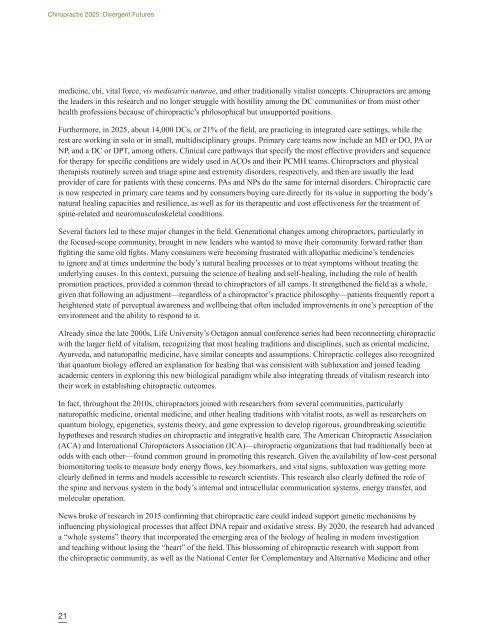Chiropractic 2025:
Chiropractic 2025:
Chiropractic 2025:
You also want an ePaper? Increase the reach of your titles
YUMPU automatically turns print PDFs into web optimized ePapers that Google loves.
<strong>Chiropractic</strong> <strong>2025</strong>: Divergent Futures<br />
medicine, chi, vital force, vis medicatrix naturae, and other traditionally vitalist concepts. Chiropractors are among<br />
the leaders in this research and no longer struggle with hostility among the DC communities or from most other<br />
health professions because of chiropractic’s philosophical but unsupported positions.<br />
Furthermore, in <strong>2025</strong>, about 14,000 DCs, or 21% of the field, are practicing in integrated care settings, while the<br />
rest are working in solo or in small, multidisciplinary groups. Primary care teams now include an MD or DO, PA or<br />
NP, and a DC or DPT, among others. Clinical care pathways that specify the most effective providers and sequence<br />
for therapy for specific conditions are widely used in ACOs and their PCMH teams. Chiropractors and physical<br />
therapists routinely screen and triage spine and extremity disorders, respectively, and then are usually the lead<br />
provider of care for patients with these concerns. PAs and NPs do the same for internal disorders. <strong>Chiropractic</strong> care<br />
is now respected in primary care teams and by consumers buying care directly for its value in supporting the body’s<br />
natural healing capacities and resilience, as well as for its therapeutic and cost effectiveness for the treatment of<br />
spine-related and neuromusculoskeletal conditions.<br />
Several factors led to these major changes in the field. Generational changes among chiropractors, particularly in<br />
the focused-scope community, brought in new leaders who wanted to move their community forward rather than<br />
fighting the same old fights. Many consumers were becoming frustrated with allopathic medicine’s tendencies<br />
to ignore and at times undermine the body’s natural healing processes or to treat symptoms without treating the<br />
underlying causes. In this context, pursuing the science of healing and self-healing, including the role of health<br />
promotion practices, provided a common thread to chiropractors of all camps. It strengthened the field as a whole,<br />
given that following an adjustment—regardless of a chiropractor’s practice philosophy—patients frequently report a<br />
heightened state of perceptual awareness and wellbeing that often included improvements in one’s perception of the<br />
environment and the ability to respond to it.<br />
Already since the late 2000s, Life University’s Octagon annual conference series had been reconnecting chiropractic<br />
with the larger field of vitalism, recognizing that most healing traditions and disciplines, such as oriental medicine,<br />
Ayurveda, and naturopathic medicine, have similar concepts and assumptions. <strong>Chiropractic</strong> colleges also recognized<br />
that quantum biology offered an explanation for healing that was consistent with subluxation and joined leading<br />
academic centers in exploring this new biological paradigm while also integrating threads of vitalism research into<br />
their work in establishing chiropractic outcomes.<br />
In fact, throughout the 2010s, chiropractors joined with researchers from several communities, particularly<br />
naturopathic medicine, oriental medicine, and other healing traditions with vitalist roots, as well as researchers on<br />
quantum biology, epigenetics, systems theory, and gene expression to develop rigorous, groundbreaking scientific<br />
hypotheses and research studies on chiropractic and integrative health care. The American <strong>Chiropractic</strong> Association<br />
(ACA) and International Chiropractors Association (ICA)—chiropractic organizations that had traditionally been at<br />
odds with each other—found common ground in promoting this research. Given the availability of low-cost personal<br />
biomonitoring tools to measure body energy flows, key biomarkers, and vital signs, subluxation was getting more<br />
clearly defined in terms and models accessible to research scientists. This research also clearly defined the role of<br />
the spine and nervous system in the body’s internal and intracellular communication systems, energy transfer, and<br />
molecular operation.<br />
News broke of research in 2015 confirming that chiropractic care could indeed support genetic mechanisms by<br />
influencing physiological processes that affect DNA repair and oxidative stress. By 2020, the research had advanced<br />
a “whole systems” theory that incorporated the emerging area of the biology of healing in modern investigation<br />
and teaching without losing the “heart” of the field. This blossoming of chiropractic research with support from<br />
the chiropractic community, as well as the National Center for Complementary and Alternative Medicine and other<br />
21


